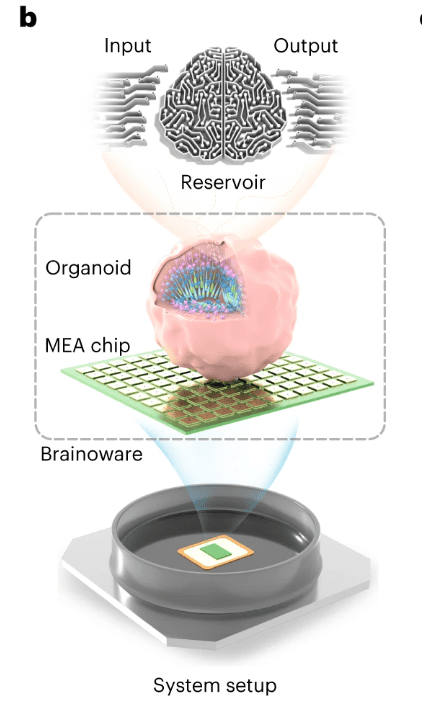Researchers at Indiana State University in the United States have created a system called Brainoware that connects brain organs – so-called organoids – to electronic circuits, allowing brain tissue and circuits to send and to receive electrical signals. This work was published on November 11 in the journal Nature Electronics.
Organoids are small biological organs grown from stem cells. They are used in medical research and should eventually replace laboratory animals. In this study, the brain organoids are a few square millimeters in size and made up of around 100 million nerve cells.
The researchers converted the information they wanted to transmit into electrical signals and sent them to brain organoids, which detected and interpreted the responses using sensors and machine learning algorithms.
Brainoware speech recognition accuracy reached 78%
They converted 240 voice files recorded by eight people into electrical signals and trained them in an unsupervised manner. The brain organoids displayed different neural signal patterns for each voice. As training progressed, Brainoware’s speech recognition accuracy reached 78%.

Conceptual diagram of Brainoware, which connects cerebral organoids and electronic circuits (Source: Nature Electronics)
According to the researchers, Brainoware shows that it is possible to integrate biological neural networks and artificial neural networks. This could help solve the problem of current LLMs which consume a lot of energy.
Mimicking the brain’s ability to operate efficiently with less energy could thus revolutionize the structure of current computers, where the storage and processing of information are separated, creating bottlenecks and energy consumption. high energy.
Increase the lifespan and size of organoids
Researchers also hope that brain organoid research will improve our understanding of the brain and lead to advances in the treatment of neurodegenerative diseases such as Alzheimer’s.
However, this is still a POC. The challenge still lies in increasing the lifespan and size of organoids. The organoids used in the study took two to three months to grow, with a lifespan of one to two months. Larger organoids are needed to perform more complex tasks. And for most tasks, traditional AI is still much more efficient and effective.
“There is still much work to be done to connect organoids to AI,” said Peng Guo, a professor at Indiana State University. “The next challenge will be finding ways to make brain organoids more stable and enable them to accomplish more complex tasks.
Source: “ZDNet Korea”
